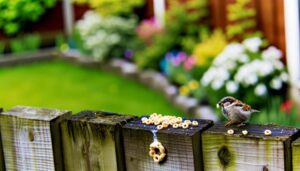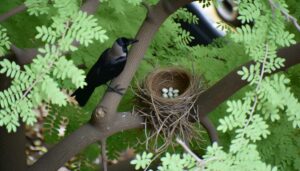How Do Sparrows Feed Their Young: A Guide
Sparrows feed their young primarily soft invertebrates, such as caterpillars and aphids, to meet their high protein needs for rapid growth. Parent sparrows forage for insects using techniques like aerial hawking and ground foraging.
They feed nestlings approximately four to twelve times per hour, with each feeding occurring every 10 to 15 minutes during early developmental stages. This high-frequency feeding guarantees that nestlings receive essential nutrients, including proteins, lipids, vitamins, and minerals.
Nutritional strategies and selective food choice are vital for robust development. To explore the intricate feeding behaviors and adaptations of sparrows, more insights are available.
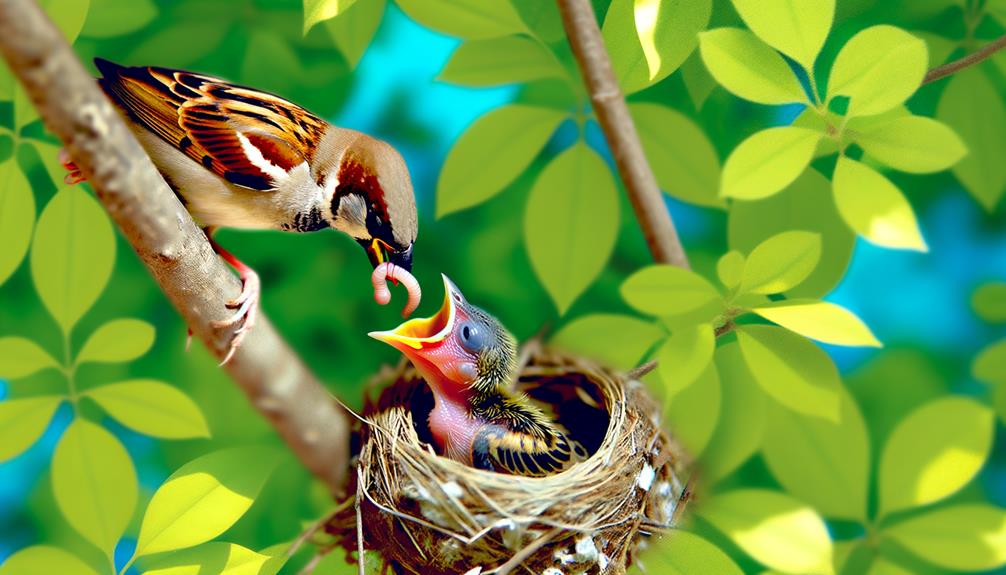
Key Takeaways
- Sparrows feed their young primarily soft invertebrates like caterpillars and aphids for high protein.
- Parents feed nestlings approximately four to twelve times per hour, depending on age and food availability.
- Feeding frequency ranges from every 10 to 15 minutes, especially in early developmental stages.
- Sparrow nestlings' diet includes insects for protein, seeds for carbohydrates, and fruits for vitamins and minerals.
- Sparrows use techniques like aerial hawking and ground foraging to gather diverse food sources.
Nesting and Hatching
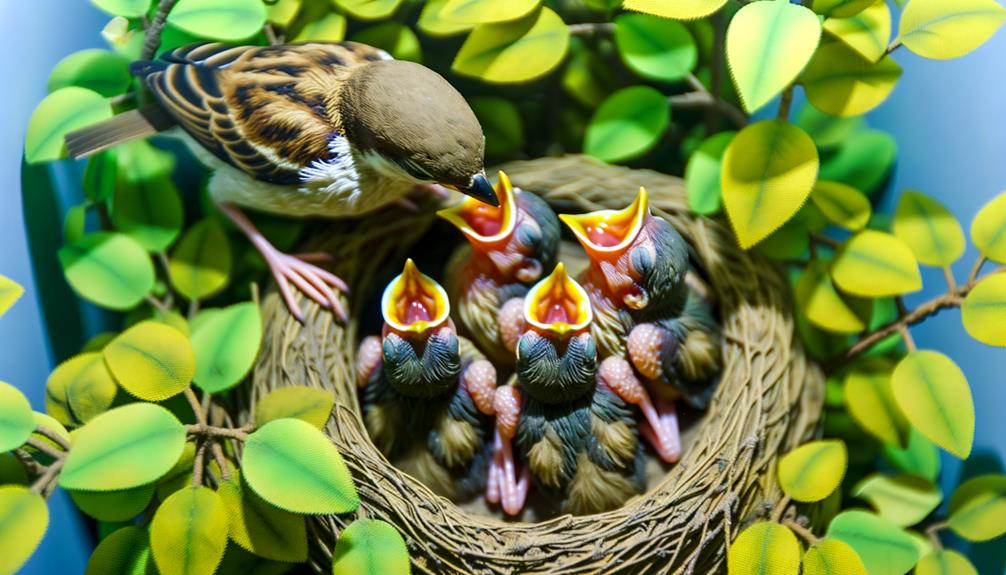
The nesting and hatching phase in sparrows involves careful selection of nesting sites. Sparrows prefer cavities in trees, eaves, and dense vegetation for optimal protection and temperature regulation. These locations provide perfect conditions for the developing eggs, maximizing microclimatic conditions.
Observations reveal that females lay clutches of 3-7 eggs, with an average incubation period of 11-14 days. Temperature stability is crucial for embryonic development, and it is maintained through rhythmic brooding patterns.
Studies show that nest site selection significantly impacts hatching success rates. Sheltered nests have lower predation rates and higher hatchability. Empirical evidence highlights the importance of nest material selection, such as grass and feathers, in enhancing insulation and moisture control. This ensures ideal hatching outcomes.
Initial Feeding Habits
Upon hatching, sparrow nestlings primarily consume a diet consisting of soft invertebrates, such as caterpillars and aphids, which provide essential proteins and nutrients.
Observational studies indicate that parents feed their young approximately four to twelve times per hour, depending on environmental conditions and food availability.
This initial feeding frequency is critical for the rapid growth and development of the nestlings during the first few days post-hatching.
Early Food Sources
In the initial phases of development, sparrow nestlings mostly rely on a diet rich in protein, mainly sourced from insects such as caterpillars and beetles. This high-protein diet is crucial for rapid growth and development. Observational studies indicate that parent sparrows exhibit selective foraging behavior to meet the nutritional needs of their young. The following table outlines common early food sources and their protein content:
| Insect Type | Protein Content (%) | Frequency in Diet (%) |
|---|---|---|
| Caterpillars | 56 | 40 |
| Beetles | 45 | 30 |
| Spiders | 50 | 15 |
| Grasshoppers | 48 | 10 |
| Ants | 42 | 5 |
These dietary choices ensure the nestlings receive sufficient nutrients, fostering optimal physiological development during their early life stages.
Feeding Frequency
During the early stages of development, sparrow nestlings are fed by their parents at intervals ranging from every 10 to 15 minutes, ensuring a consistent and ample supply of nutrients necessary for growth.
This frequent feeding regimen is critical for maintaining the high metabolic rate of the rapidly growing chicks. Observational studies have documented that each feeding session typically involves the delivery of a diverse array of food items, primarily consisting of insects and small invertebrates.
Quantitative data indicates that, on average, a parent sparrow delivers food to the nest approximately 200 to 300 times per day. This intensive feeding strategy maximizes nutrient intake, facilitating efficient development and enhancing survival rates during the vulnerable fledgling period.
Types of Food Provided
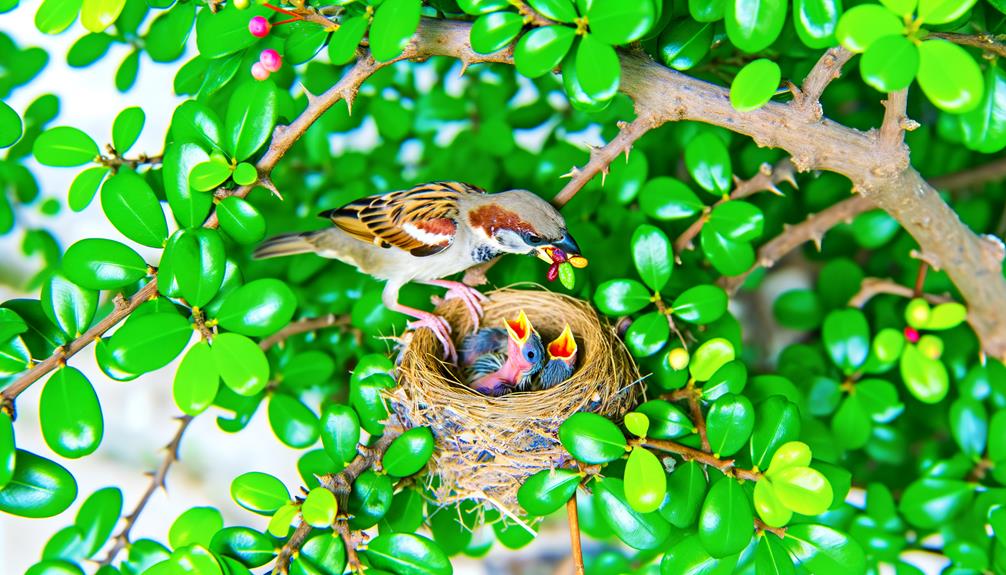
Sparrows primarily provide their young with a diet consisting of small insects, seeds, and occasionally fruits, meticulously selected to guarantee balanced nutrition. Research indicates that insects, particularly caterpillars and beetles, are rich in protein, essential for the rapid growth of nestlings. Seeds from grasses and weeds offer necessary carbohydrates, while fruits contribute important vitamins and minerals. The table below delineates the primary food types and their nutritional contributions:
| Food Type | Nutritional Component | Primary Source Examples |
|---|---|---|
| Insects | Proteins | Caterpillars, Beetles |
| Seeds | Carbohydrates | Grass seeds, Weed seeds |
| Fruits | Vitamins, Minerals | Berries, Small fleshy fruits |
Gathering Food Sources
In the context of gathering food sources, sparrows employ a combination of insect hunting techniques and seed selection methods to guarantee the nutritional needs of their offspring are met.
Detailed observations indicate that sparrows utilize rapid, agile movements to capture insects, while also demonstrating selective foraging behavior for nutrient-rich seeds.
Data-driven studies reveal that these feeding strategies are essential for the growth and development of their young.
Insect Hunting Techniques
Mastery of insect hunting techniques is essential for sparrows, as it directly impacts their ability to provide sufficient nourishment to their developing offspring. Insects are rich in protein, making them a critical component of the juvenile diet. Sparrows employ various strategies to capture these prey, such as aerial hawking, ground foraging, and foliage gleaning. Detailed observations reveal that adult sparrows prefer caterpillars and beetles due to their high nutritional value.
| Technique | Description |
|---|---|
| Aerial Hawking | Catching insects mid-flight |
| Ground Foraging | Searching for insects on the ground |
| Foliage Gleaning | Picking insects from leaves |
| Hovering | Hovering near foliage to catch prey |
| Probing | Using beaks to extract insects |
These techniques enhance the sparrows' efficiency in securing high-quality food sources.
Seed Selection Methods
Utilizing sharp observational skills and anatomical adaptations, adult sparrows carefully choose seeds that provide optimal energy and nutritional value for their young. Research indicates that sparrows prioritize seeds with high protein and fat content, crucial for the rapid growth of their offspring.
Their specialized beaks enable precise handling and de-husking of even the smallest seeds. Behavioral studies document sparrows' ability to distinguish between seed types through visual and tactile cues, optimizing their foraging efficiency.
Data reveals a preference for seeds from native plants, which offer higher nutrient density compared to non-native species. This selective feeding strategy guarantees that nestlings receive a balanced diet, promoting strong development and increasing survival rates during the early stages of life.
Feeding Frequency
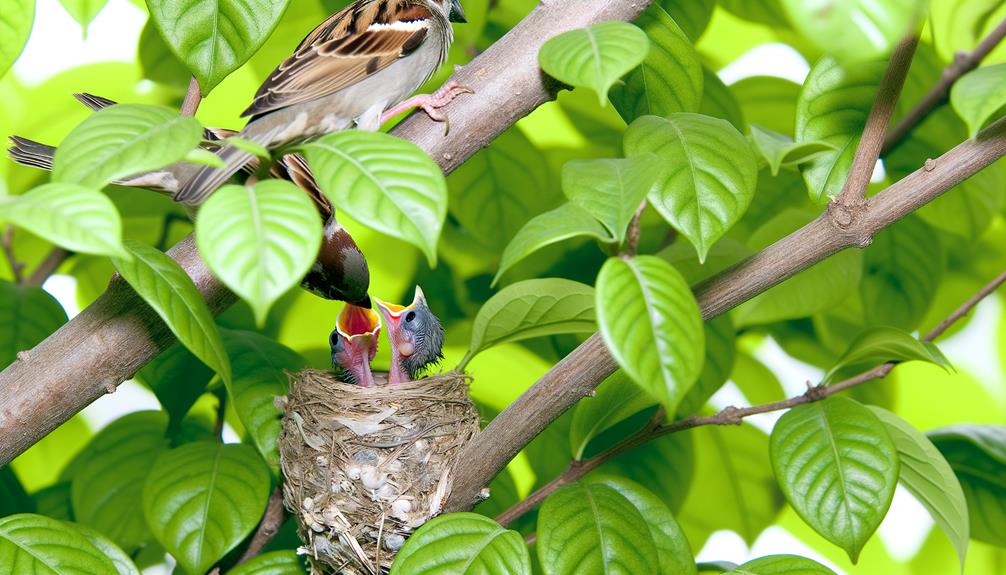
The feeding frequency of sparrows is influenced by various factors including the age of the chicks, environmental conditions, and availability of food resources. Observational data indicate that newly hatched chicks require feeding approximately every 15-20 minutes due to their rapid metabolic rate and growth demands.
As the chicks mature, the interval between feedings extends, with older nestlings being fed every 30-60 minutes. Environmental conditions such as temperature and weather can further modulate feeding patterns; for instance, cooler temperatures necessitate increased feeding to provide adequate energy for thermoregulation.
Additionally, the availability of food resources, particularly during times of scarcity, can have a significant impact on feeding frequency, with parents potentially reducing feeding intervals to ensure chick survival. These patterns highlight the dynamic nature of sparrow chick provisioning.
Role of Both Parents
Both parents play an essential role in the feeding and care of sparrow chicks, engaging in a highly coordinated effort to maximize offspring survival and growth. Male and female sparrows exhibit division of labor and shared responsibilities, ensuring constant nourishment and protection for their young.
Observational studies indicate that both parents partake in frequent feeding missions, exhibiting a high degree of synchronization.
- Parental Roles: Both sexes contribute to chick provisioning, with males often sourcing food while females tend to nest maintenance.
- Feeding Rates: Data shows that feeding rates can exceed 20 visits per hour during peak demand periods.
- Chick Monitoring: Constant vigilance is maintained to detect and respond to predation threats.
- Thermoregulation: Parents alternate brooding to regulate chick temperature.
- Communication: Vocalizations are used to coordinate feeding and alert to dangers.
Nutritional Needs

In the early stages of development, sparrow nestlings require a diet rich in proteins and lipids to support rapid growth and feather development. Observational data indicate that parents typically feed their young at intervals of approximately 4-6 times per hour, adjusting the frequency based on the age and nutritional demands of the offspring.
Essential nutrients are primarily derived from a diverse array of insects and invertebrates, supplemented occasionally with seeds and plant matter.
Essential Nutrients Required
Consistently, sparrows require a well-balanced diet rich in proteins, fats, carbohydrates, vitamins, and minerals to guarantee the healthy development of their offspring. Detailed observations and empirical data reveal that these essential nutrients are essential for optimal growth and physiological functions.
- Proteins: Important for tissue development and repair, aiding in muscle and feather growth.
- Fats: Provide a concentrated energy source, essential for maintaining metabolic activities.
- Carbohydrates: Serve as a primary energy source, supporting vigorous activity levels.
- Vitamins: Crucial for various biochemical processes, particularly Vitamin A for vision and immune function.
- Minerals: Elements like calcium and phosphorus are necessary for bone development and structural integrity.
These nutrients collectively optimize the robust health and survival of young sparrows, underscoring the significant role of a diverse diet.
Feeding Frequency Patterns
Understanding the nutritional composition is just one part of maintaining the well-being of young sparrows; equally important is the feeding frequency that aligns with their developmental needs.
Studies have shown that sparrow parents feed their nestlings approximately 4-12 times per hour, depending on the age and species. Newly hatched chicks demand higher frequency due to their rapid growth and metabolic rates.
Observational data indicate a peak feeding frequency in the first week, gradually decreasing as fledglings develop. This high frequency ensures optimal nutrient absorption, essential for the development of feathers, muscles, and organs.
Additionally, food delivery frequency directly correlates with parental foraging efficiency and environmental food availability, highlighting the adaptive nature of these feeding patterns.
Feeding Techniques
Sparrows utilize a variety of feeding techniques, meticulously selecting and delivering food to their nestlings to ensure ideal nutrition and growth. These techniques are crucial for guaranteeing the survival and health of the offspring.
Observations indicate that sparrows primarily forage for high-protein insects and larvae, essential for rapid development. The parents exhibit precise coordination in food delivery, often alternating feeding turns to maintain a steady supply of sustenance.
Key feeding techniques include:
- Selective Foraging: Prioritizing nutrient-rich prey.
- Proportional Allocation: Distributing food based on nestling size and hunger levels.
- Regurgitation: Softening food for easier digestion.
- Crop Storage: Temporarily holding food in the crop for delayed feeding.
- Hygienic Feeding: Cleaning the nest area to prevent contamination.
These methods collectively optimize the nutritional intake during the critical growth phase.
Developmental Stages

Observations of sparrow feeding techniques provide valuable insight into the developmental stages of their young. This reveals how nutritional strategies are tailored to each phase of growth. Initially, hatchlings are primarily fed protein-rich insects such as caterpillars and beetles, essential for rapid growth.
As fledglings progress, their diet diversifies to include seeds and plant matter, indicating a shift toward self-sufficiency. Empirical data show a significant correlation between diet composition and growth rates, with insect intake peaking during the first week post-hatching.
Detailed studies also highlight that parental feeding frequency and prey selection are carefully adjusted based on chick development, ensuring ideal nutrient intake. These adaptive strategies underscore the importance of targeted feeding in fostering robust juvenile sparrows.
Challenges and Adaptations
Exploring the complexities of environmental changes, sparrows employ a range of adaptive feeding strategies to secure the survival and growth of their offspring. These small avians face numerous challenges, including fluctuating food availability and predation risks.
To mitigate these challenges, sparrows have developed several adaptive behaviors and physiological adjustments:
- Temporal foraging: Adjusting feeding times based on predator activity and food availability.
- Dietary flexibility: Switching between seeds, insects, and other available nutrients.
- Nest site selection: Choosing locations that offer better protection from predators and harsh weather.
- Parental investment: Both parents participate in feeding to maximize nutrient delivery.
- Brood reduction: Selective feeding based on chick health to guarantee the survival of the fittest.
These strategies are essential for securing the successful rearing of their young under variable environmental conditions.
Conclusion
To sum up, sparrows demonstrate intricate feeding behaviors to guarantee the survival and growth of their offspring. Remarkably, parent sparrows can make over 400 trips daily to gather food, showcasing an exceptional dedication to nurturing their young.
The dietary routine, consisting of insects and seeds, is carefully adjusted to meet the changing nutritional needs of the nestlings. These adaptive strategies emphasize the remarkable resilience and resourcefulness of sparrows in overcoming environmental challenges to effectively rear their progeny.




